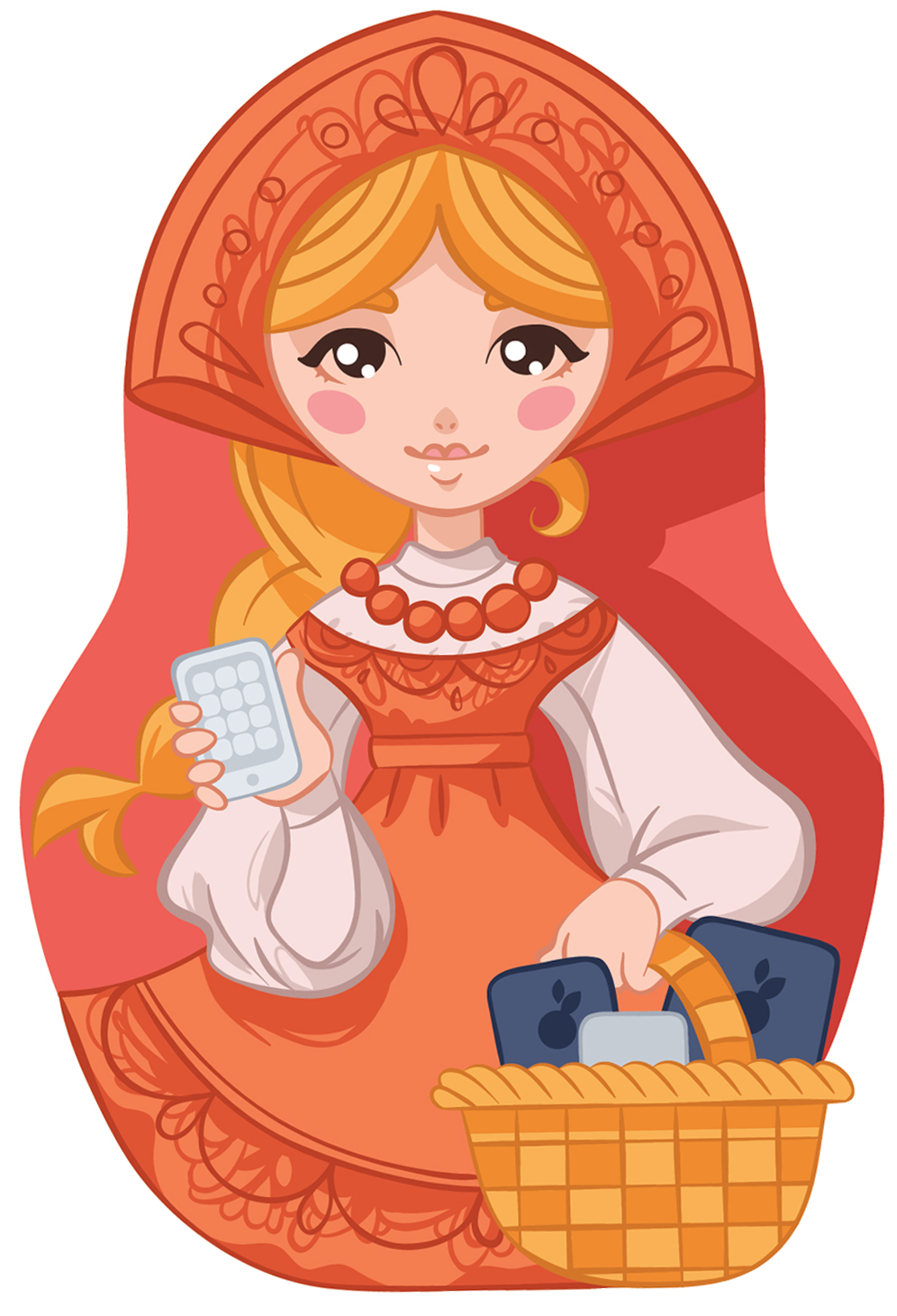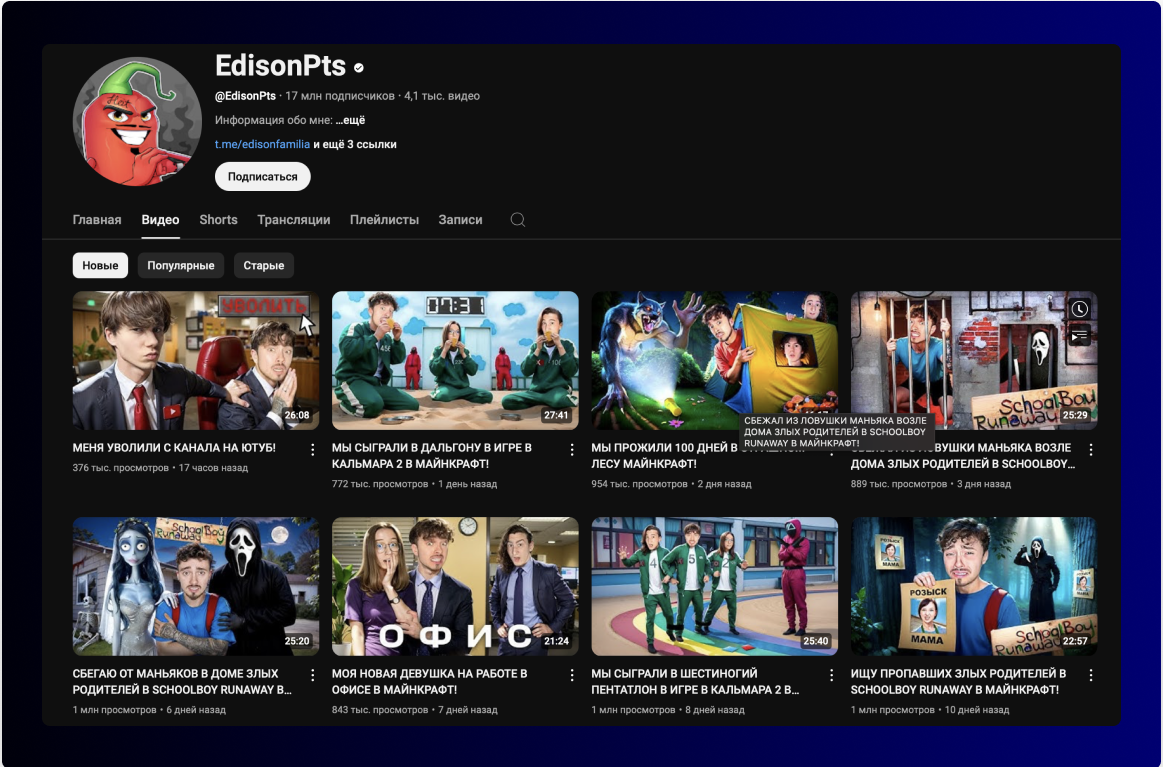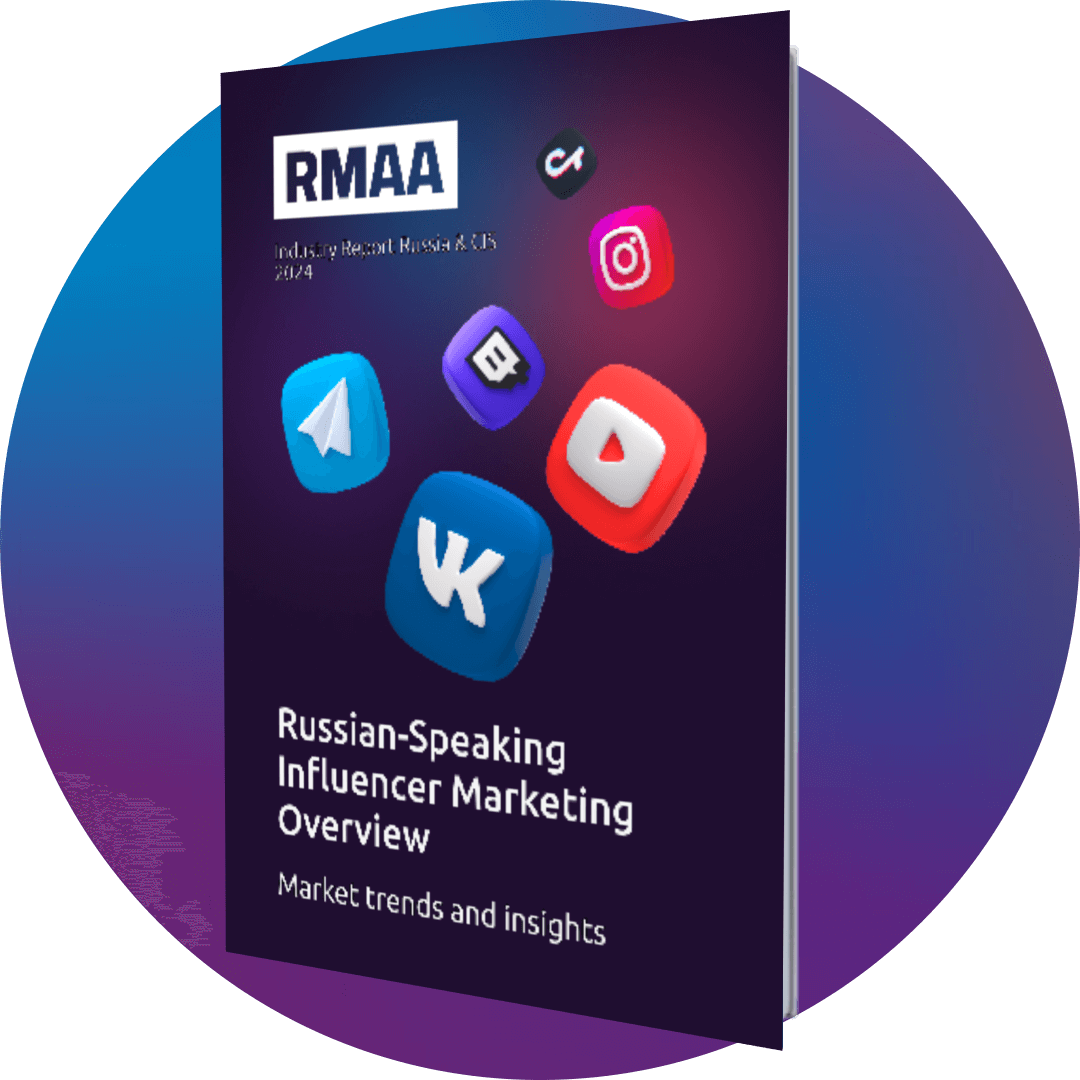Blog about successful marketing strategies in russia
A Complete Russian YouTube Overview for Marketers. Key Market Insights


DIGITAL MARKETING
Share this Post
Last year, YouTube’s audience in Russia underwent some changes. In July 2024, the average monthly audience was around 95.8 million, but by December, it had decreased to 89.5 million. Daily audience also declined. Between August and November, it dropped by 11%, reaching 46 million users.
The shrinkage in YouTube's audience in Russia is linked to service slowdowns. Roskomnadzor restricted access speed to the platform due to violations of Russian legislation and failure to remove prohibited content.
Nevertheless, YouTube remains one of the most popular platforms in Russia, ranking 6th in terms of monthly audience. Many users and bloggers continue to access the platform via VPN. Additionally, an analysis of popular bloggers’ rankings shows an increase in subscriber numbers, indicating stable audience engagement.
|
|
|
|
|
|
|
|
|
|
|
|
|
|
|
|
|
|
|
|
|
|
|
|
|
|
|
|
|
|
|
|
|
|
|
|
|
|
|
|
|
|
|
|
|
|
|
|
|
|
|
|
|
|
|
In this article, we will explore the specifics of the Russian YouTube audience, the impact of Google advertising restrictions and government-imposed blocks on the platform, as well as effective strategies for brand promotion under these conditions.
Russian YouTube Today: Facts and Figures
As of today, official Russian media, citing Mediascope research, report that the average time spent on YouTube by Russian users has decreased to 91–92 minutes per day. The primary reason is the platform’s slowdown, making it harder for many users to load videos and navigate the site comfortably.
However, these figures may not be entirely accurate. Following service disruptions in August, many users turned to VPN services to bypass restrictions, as evidenced by a sharp increase in VPN app downloads. Due to the technical limitations of VPN usage, it is impossible to determine the exact number of Russian users who continue to watch videos on the platform. As a result, official data on declining watch time may not fully reflect the reality. Nevertheless, even the available statistics indicate that YouTube in Russia is not losing its position. Let’s take a closer look:
-
Until late July 2024, the average daily watch time was 111 minutes, but by the end of August, it had dropped to 91–92 minutes.
-
Russian users still spend around 91 minutes per day watching videos on the platform.
-
Since July 2024, creator activity on YouTube has declined by 34%, while the amount of content produced has decreased by 22%. However, an analysis of rankings over different periods shows a subscriber increase among popular bloggers, particularly in the gaming niche, where creators continue to upload videos at a steady pace, EdisonPts, for example.

Current videos on the popular YouTube gaming channel EdisonPts
Russian YouTube Users – Who Are They?
Most Russian YouTube users are aged 25-34 years and this segment accounts for 20.7% of all audience. The second place are 35-44 year-old-people (16.7%), followed by users between the ages of 18 and 24 (15%).
Women prevail among Russian YouTube audience, making up 52.8% whereas men account for 47.4%.
Since 91.3% of Russians use the Internet on their mobile devices, it is logical to assume that the majority of users watch YouTube videos in the mobile apps.
An interesting trend: What is also important to note, despite the younger audience in the country prefer YouTube instead of TV, older Russians still spend much time watching content on TV. To cover more segments TV-companies launch their own channels on YouTube for streaming their shows. This is one of the reasons why the platform is so widespread and popular among people of different ages.
What Do Russian Users Watch on YouTube
In the face of audience aging, the share of views of children and entertainment video has increased, while main consumers of bloggers’ video are still viewers under 18 years old, which share reaches 40%, according to the study by Yoola media network. As for kids, more often it is their mothers who turn them on, or women aged 24-44.
While the audience gets older, its preferences change, too. In the category aged 18-24, bloggers are still in favor, but there are also gaming and entertainment coming. These genres are also popular among YouTube users aged 25-44. Apart from that, there is a category of themed videos. Men start getting interested in business, cars, and gadgets, while women, on the contrary, watch videos about fashion, beauty, health, motherhood, sports, shopping, and lifestyle. However, in the age of 35 women start losing interest to themed content, while male context remains relevant for its audience.
At the age of 44 years and more, audience preferences shift to entertainment and hobby videos. Most popular ones become life hacks, DIY. People watch video about travelling, cooking, gardening, knitting, and other activities. Yoola notes that such themes are most often presented by small thematic channels. Unlike other content categories, in the DIY category bloggers as channel authors are of lesser importance: presenters can change, an author’s face does not need to appear on camera, while viewers will only be interested in usability of the content watched.
What is more, working with various communication channels, we noticed that the YouTube audience is the toughest one: all negative aspects are welcomed in a video. On the other hand, the ‘kindest’ audience of Russian users is on Odnoklassniki.
Russian Channels which Lead in the Number of Views and Subscribers
Some of the most popular YouTube channels in Russia are those targeted at children and teenagers.
|
|
|
|
|
|
|
|
|
|
|
|
|
|
|
|
|
|
|
|
|
|
|
|
|
|
|
|
|
|
|
|
|
|
|
|
|
|
|
|
|
|
|
|
|
|
|
|
|
|
|
|
|
|
|
|
|
|
|
|
|
|
|
|
|
|
|
|
|
|
|
|
|
|
|
|
|
|
|
|
|
|
|
|
|
|
|
|
|
|
|
|
|
|
|
|
|
|
|
|
|
|
|
|
|
At the top of the rankings is the English-language channel Kids Diana Show (1st place) followed by Like Nastya (2nd place).
Kids Diana Show is led by Diana, the main character of the videos, who, along with her brother Roma, participates in various games, toy unboxings, and educational content.
Roma also has his own channel, Kids Roma Show, which ranked 7th in the TOP list.
The Like Nastya channel follows the adventures of Nastya, who, along with her parents, travels, plays, and takes part in various educational and entertainment activities.
Nastya showcasing popular Barbie dolls in a video
In third place is the popular blogger and entrepreneur Vlad Bumaga (A4). Vlad posts challenges, pranks, experiments, and entertainment videos aimed at a young audience.
The fourth and fifth spots are held by the channels Get Movies and Masha and the Bear.
Get Movies features cartoons, children's songs, and other entertaining content for kids. Masha and the Bear is the official channel of the popular Russian animated series, telling the story of Masha, a little girl, and her friend the Bear. The channel also has an English-language version, which ranked 6th in the list.
At the lower end of the rankings are kids' channels such as Vania Mania Kids (8th place) and Eva Bravo Play (10th place). The 9th place is held by Chapitosiki, a channel starring adorable dachshund twins Chapitosiki and their owners, sisters Kamilla and Ariana.
Megamarket advertising integration in a video on the Chapitosiki channel
The second half of the TOP 20 bloggers is more diverse and includes creators with both young and adult audiences. For example, Glent, who produces challenges and experiments is ranked 13th, SlivkiShow (scientific experiments, life hacks, and interesting facts) – 15th, HiMan (challenges and experiments) – 17th, Marmok (gaming blogger) – 19th, and Dima Maslennikov (blogger and TV host) – 20th.
There are also children's channels: Miss Katy (11th place), Mister Max (12th), Like Nastya Vlog (14th), Poznavatel (16th), and Miroshka TV (18th).
How to Advertise on Russian YouTube after Google Restrictions
In the spring of 2022 Google imposed a ban for any ads from Russian advertisers on all services of the company. YouTube is no exception – Russian users don’t see any direct advertising on the platform, and bloggers’ content is not monetized officially anymore.
But this circumstance didn’t make YouTube an inefficient platform for business,on the contrary, it encouraged advertisers in Russia to search for alternative ways for promoting their products. Bloggers have easily adapted to the changes and introduced new forms of native advertising such as preroll, midroll and postroll which are similar to direct YouTube ads in terms of videos’ timing. Furthermore, many vloggers increased the number of advertising integrations without facing the significant outflow of subscribers.
It’s not a secret that popular bloggers can make a strong influence, and this concerns not only a fanbase but even a more or less loyal audience. Native promoting of the product in influencer’s video is not so annoying as the official ads, and can be a very strong tool in case of matching of target audience. According to research, users bought goods and services following the recommendation of some blogger. And 46% of people who watch vlogs take into account their favorite blogger’s opinion before buying anything.
On Russian YouTube you may now see such formats of native ads as voiceover videos, humorous sketches, special issues and interviews, mentions, etc.
Regulatory Nuances
It seems that marketers even win in the situation where they have to buy advertising directly from YouTube bloggers insteade of paying Google. But there is one serious problem you may face placing ads on YouTube in Russia – you must mark it and do it correctly.
On the first of September, 2022, updated advertising law entered into force, which obliges marketers to mark any ad and send appropriate data to the United Register of Internet Advertisements. The snag is that advertisers can’t submit such information to the Register directly, there are operators of advertising data acting as mediators between companies and government. The marketers have to send their ads with an indication of advertiser, advertisement platform, mediator, etc. to these operators. The disruption of the chain can cause large fines of up to 500 000 roubles for one unmarked ad.

Advertising and its labeling under a video on the Chapitosiki channel
As you see, it is quite easy to get confused with legal features of marking ads, among which YouTube native promoting, in Russia. To avoid the troubles with ads marking and minimize the risk of being fined we strongly recommend you delegate advertising to the competent and reliable agency.
Additionally, starting from November 1, 2024, all bloggers with more than 10,000 subscribers must submit information about themselves and their channels to Roskomnadzor. Without proper registration, channel owners are prohibited from placing advertisements. Failure to comply with the law may result in temporary or permanent account suspension and fines ranging from 2,000 to 500,000 rubles. No penalties for advertisers have been introduced so far.
YouTube Trends: Summary
Following the results of the aforesaid, we can come to a conclusion that YouTube will continue to gain popularity and be attractive for Russians. And despite restrictions on direct advertising for marketers in Russia there are still efficient and powerful tools for promoting on the platform. Careful study of your target audience and competent choice of vloggers may bring really high results.
If you have a goal to use this video service for ads placement, RMAA Group experts are always ready to provide you with knowledgeable assistance. If you want to get more detailed information on analytics of visitation of Russian popular Internet portals and, in particular, YouTube, please download a free version of our White Paper ‘Russian Digital Market Overview’. The information contained therein will help to learn the activeness indicators of various categories of Russian users who prefer the Internet, including YouTube that is famous in Russia for its informational value and entertaining component.
Join 2,000+
of your Peers!
You will be the first to know about Russian marketing insights, news and updates from our agency. Stay tuned!
Get our latest articles delivered to your email inbox and get our exclusive White Paper
"Digital Marketing in Russia. Finding your customers on the internet"
for FREE!
Russian-Speaking Influencer Marketing Overview
Further insights and trends in the Influencer Industry within Russia and the CIS

Ready to partner with the specialists in Russian marketing and advertising?
About the Author
Digital Strategist. Head of one of the project groups at RMAA. Maria started her journey in digital marketing in 2009.
Join 2,000+ of your Peers!
Get our latest articles delivered to your email inbox and get our exclusive White Paper "Digital Marketing in Russia. Finding your customers on the internet" for FREE!
You will be the first to know about Russian marketing insights,
news and updates from our agency.
Stay tuned!
We're updating our website's design step by step, so some pages may look different. Thank you for your understanding.
Got it














